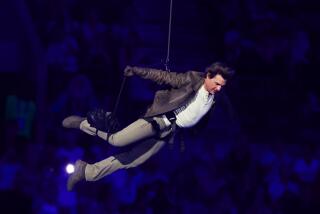Danny Boyle calls for a retake on ‘Trance’

LONDON — From the rooftop where he was filming a scene for his art heist film “Trance” in September 2011, British director Danny Boyle surveyed the construction cranes stretching across the east London skyline, finishing work for the capital’s upcoming Summer Olympics.
Boyle, perhaps best known as the man behind the Oscar-winning “Slumdog Millionaire,” pointed out the neighborhood where athletes would stay, the sites of new sports facilities and the location of the opening ceremony.
It was not idle boosterism, for as soon as he wrapped principal photography on “Trance,” Boyle would put the movie down like a baby on an epic nap. He and his creative team would then go off to stage the launch of the 2012 Summer Games — a creative celebration of British history, including a parachuting queen of England, a tribute to the National Health Service and an eclectic playlist with songs by the Sex Pistols, Pink Floyd and Arctic Monkeys.
PHOTOS: Hollywood backlot moments
“We tucked [the film] up in bed and said, ‘Night, night,’” Boyle said. When he returned to “Trance” about half a year later, though, he was surprised that he scarcely recognized what he had left in the crib. Given that the movie — about a robber with a brain injury who can’t remember where he stashed a stolen masterpiece — is principally concerned with memory, it was a fitting twist.
“At first I thought, I’ll never forget it — the way you do when you finish filming: You remember everything,” Boyle said recently while visiting Los Angeles. “But by the time we got back to the movie, I had forgotten it. The first time we watched it, after we regrouped after the Olympics, it was bizarre — I didn’t know what was coming next. I didn’t know that was possible.”
That unfamiliarity proved to be a blessing, because “Trance” — which hits theaters April 5 — is rather complicated. The hiatus helped Boyle see not only where the movie wasn’t lucid but also where it was too obvious. And perhaps most important, he discovered that it needed a new ending.
Soon after “Trance” begins, a seemingly lily-white auctioneer named Simon (James McAvoy) is revealed to be the inside man in the robbery of a Goya. Struck on the head during the heist, Simon can’t recollect for ringleader Franck (Vincent Cassel) and his gang of thieves where he hid the canvas.
Franck decides that hypnotist Elizabeth (Rosario Dawson) could jog Simon’s memory, and it turns out that Simon is highly susceptible to trances. What Elizabeth uncovers in her sessions with Simon may have less to do with the painting’s whereabouts than her subject’s suppressed personal history.
Planting a seed
Boyle, 56, had been ruminating on “Trance” for nearly 20 years; soon after he made the crime thriller “Shallow Grave” in 1994, screenwriter Joe Ahearne sent the director his “Trance” screenplay. Oddly, Ahearne didn’t want Boyle behind the camera — he was hoping for his encouragement. But Boyle wasn’t sure Ahearne, who hadn’t directed anything at the time, was ready for such a complex tale. “It’s quite difficult to do this,” Boyle told Ahearne.
Ahearne ultimately made the script into a television movie in 2001. But the screenplay’s central conceit and title lodged deep in Boyle’s mind and bubbled up two decades later.
Boyle said he was smitten as much by the genre — he’s moved from zombie tales to Bollywood to biographical drama — as by the fact that its protagonist was not a man. “I have two daughters who are in their 20s now, and I had never made a movie where the woman was the absolute engine of the movie,” Boyle said. “And I loved that challenge, because I make boys movies, really.”
After a screenplay overhaul by frequent Boyle collaborator John Hodge (“Trainspotting,” “Shallow Grave,” “The Beach,” “A Life Less Ordinary”), Boyle had a script he was ready to film (Ahearne, who came up with the original plot, shares screenplay credit). But how could Boyle possibly make a movie and stage the opening ceremony at the same time?
Boyle said that when he took the Olympics job in summer 2010, a friend warned that he would “go mad if you don’t do anything else” during the two years of preparation for the Summer Games. So like an athlete who doesn’t want to overtrain for a race, the filmmaker carved out two hiatuses within his Olympic schedule.
During the first, he directed a critically lauded stage production of “Frankenstein” in London in February 2011. After focusing on the Olympics over the spring and summer, he filmed “Trance” later that year.
“Frankenstein” and “Trance” were supposed to be simple breaks from the endless stream of Olympic committee meetings, but Boyle came to realize they served a deeper creative purpose.
Boyle has a predilection for memorably distressing scenes: Ewan McGregor’s toilet bowl-diving junkie in “Trainspotting”; a child being blinded in “Slumdog”; and James Franco’s character severing his arm, trapped by a falling rock, as a hiker in “127 Hours.” With several explicit images, including one of torture and another of a gunshot victim, “Trance” served as Boyle’s R-rated holiday from the G-rated Summer Games.
“When you’re doing something that is family friendly, national pride, for everyone — no swearing, nothing too dark, it has to be accessible for everyone — you realize that ‘Frankenstein’ and ‘Trance’ are the evil twin sisters of the Olympic opening ceremony,” Boyle said. “They are the dark side — they are where you have to go to replenish your spirit.”
It appears to have worked in reverse too. Boyle said the experiences of “Frankenstein” and “Trance” made him more artistically inspired to work on the Olympics, a job he considers a tremendous national honor. “You kind of go dry, really. The execution is so laborious,” Boyle said of Olympic procedures.
Even with so much bureaucracy and politics, Boyle said he would have loved working on the Games regardless of how they were received. “Even if it hadn’t gone so well, I knew I was very, very proud of it,” he said.
Olympic inspiration
Returning to “Trance” after the Olympics, Boyle found the break had opened his eyes to where the film might have underplayed its hand. Because the story hinges on several secrets being unearthed through and around hypnosis, he was better able to see how much the actors did — or did not — reveal their back stories.
It was a concern the cast and the director had struggled with during filming. “That was a big issue for me,” said McAvoy, who is playing Macbeth in London. “Instinctively, you don’t want to give anything away.”
Boyle, watching the movie for the first time in more than six months, found that the film was sometimes too timid and cryptic. “Your instinct is to give no clues at all — absolutely nothing — because you’re terrified of the slightest thing giving it away,” Boyle said. “In fact, the reality is that you can give lots of clues — and you need to give lots of clues.”
Boyle also decided that the film’s ending, juxtaposing Cassel’s and Dawson’s characters, wasn’t working, and thus he faced an unusual challenge. A year had passed since principal photography on the $20-million Fox Searchlight film had been completed, and Cassel had spent a fair amount of time surfing, becoming leaner and tanner. Dawson said her figure had changed too, but not in the same direction. But she agreed that the ending “felt too obvious.” “That took away from how modern the film feels,” she said.
As originally scripted, the movie had a classic femme fatale ending — everything was tied up a little too neatly. In the new coda, filmed in London nearly a year after the movie first wrapped, Franck is left with an unusual choice, and it may determine whether he has a future with Elizabeth.
In some ways, the actors’ physical changes fit the postscript, suggesting not only that time had passed but also that Elizabeth and Franck had become different people.
Boyle, who is now developing two period movies (he won’t provide any details but has been rumored to be considering a “Trainspotting” sequel), doesn’t intend to take a similar hiatus in making his next films. Yet he does believe the experience reminded him of one of the undeclared truths about filmmaking.
“I always find that ironic in movies: that the director is the least-qualified person to prepare a film for an audience to watch once,” Boyle said. “Because he’s seen it 2,000 times and has a completely distorted relationship with it.”
PHOTOS AND MORE
TIMELINE: Violence in movies
ENVELOPE: The latest awards buzz
PHOTOS: Greatest box office flops
More to Read
Only good movies
Get the Indie Focus newsletter, Mark Olsen's weekly guide to the world of cinema.
You may occasionally receive promotional content from the Los Angeles Times.











